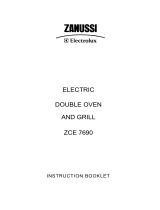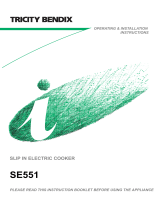
2
IMPORTANT SAFETY INFORMATION
These warnings are provided in the interests of your safety. Ensure that you understand them all before installing
or using the appliance. Your safety is of paramount importance. If you are unsure about any of the meanings of
these warnings contact the Customer Care Department.
INSTALLATION
The appliance must be installed according to the
instructions supplied. The installation work must be
undertaken by a qualified electrician/competent
person.
The appliance must be installed in an adequately
ventilated room.
If the appliance is to be placed on a base, measures
must be taken to prevent the appliance slipping from
the base.
This appliance is heavy and care must be taken when
moving it.
Warning: Do not attempt to lift or move this appliance
by the handles.
All packaging, both inside and outside the appliance
must be removed before the appliance is used.
It is dangerous to alter the specifications or modify the
appliance in any way.
After installation please dispose of the packaging with
due regard for safety and the environment.
Your local authority can arrange this.
CHILD SAFETY
Do not allow young children to play with any part of
the packaging.
This appliance is designed to be operated by adults.
Young children must not be allowed to tamper with
the controls or play near or with the appliance.
CAUTION: Accessible parts may be hot when in
the grill is in use. Young children should be kept
away.
DURING USE
This appliance is not intended to be operated by
means of an external timer or separate remote control
system.
This appliance has been designed for domestic use to
cook edible foodstuffs only, and must not be used for
any other purposes.
Take great care when heating fats and oils as they will
ignite if they become too hot.
Never place plastic or any other material which may
melt in or on the oven.
Always stand back from the appliance when opening
the doors to allow any build up of steam or heat to
release.
Always use oven gloves to remove and place food in
the oven.
Ensure that all vents are left unobstructed to ensure
ventilation of the oven cavity.
Ensure cooking utensils are large enough to contain
foods to prevent spillage and boil over.
During use the appliance becomes hot. Care should
be taken to avoid touching heating elements inside the
oven.
You must ensure that the grill control is in the 'OFF'
position when the timer control has been set for
automatic cooking.
The handles of saucepans, which are smaller than
the heated area on the hob, will become hot.
Ensure your hand is protected before handling the
pan.
Do not leave the hotplates switched ON for long
periods when not covered by a saucepan. The
controls and cabinets may overheat.
Do not use the appliance if the ceramic glass is
damaged. If a fault or crack becomes visible,
disconnect the appliance immediately from the
electricity supply and contact your local service
force centre.
Do not place foil or plastic containers on ceramic
glass.
Ensure the anti-tilt shelves are put in correctly.
Never line any part of the appliance with foil. Do
not allow heatproof cooking material, e.g. roasting
bags, to come into contact with oven elements.
Never leave the appliance unattended when the
oven door is open.
Do not place sealed cans or aerosols inside the
oven. They may explode if they are heated.
Ensure that all control knobs are in the OFF
position when not in use.
Do not stand on the appliance or on the open
doors.
Do not hang towels, dishcloths or clothes from the
appliance or its handles. They are a safety hazard.
Do not use this appliance if it is in contact with
water. Never operate it with wet hands.
CLEANING AND MAINTENANCE
For hygiene and safety reasons this appliance
should be kept clean at all times. A build-up of
fats or other foodstuffs could result in a fire
especially in the grill pan.
Do not leave cookware containing foodstuffs, e.g.
fat or oil in the appliance in case it is inadvertently
switched on.
Extreme care must be taken when using a ceramic
hob scraper.
Always allow the appliance to cool down before
switching off at the wall prior to carrying out any
cleaning / maintenance work.
Only clean this appliance in accordance with the
instructions given in this book.
SERVICE
Repairs should not be carried out by inexperienced
persons as this may cause injury or serious
malfunction. This appliance should be serviced by
an authorised Service Engineer and only genuine
approved spare parts should be used.
AT THE END OF THE APPLIANCE'S LIFE
When the time comes to dispose of your appliance
please contact your local authority. They can
arrange to dispose of the appliance in a safe and
controlled manner.






















